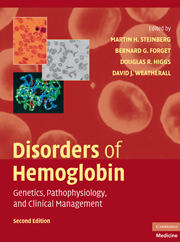Book contents
- Frontmatter
- Contents
- List of Contributors
- Foreword, by H. Franklin Bunn
- Preface
- Introduction, by David J. Weatherall
- SECTION ONE THE MOLECULAR, CELLULAR, AND GENETIC BASIS OF HEMOGLOBIN DISORDERS
- SECTION TWO PATHOPHYSIOLOGY OF HEMOGLOBIN AND ITS DISORDERS
- SECTION THREE α THALASSEMIA
- SECTION FOUR THE β THALASSEMIAS
- SECTION FIVE SICKLE CELL DISEASE
- SECTION SIX OTHER CLINICALLY IMPORTANT DISORDERS OF HEMOGLOBIN
- SECTION SEVEN SPECIAL TOPICS IN HEMOGLOBINOPATHIES
- 26 Population Genetics and Global Health Burden
- 27 Genetic Modulation of Sickle Cell Disease and Thalassemia
- 28 Laboratory Methods for Diagnosis and Evaluation of Hemoglobin Disorders
- SECTION EIGHT NEW APPROACHES TO THE TREATMENT OF HEMOGLOBINOPATHIES AND THALASSEMIA
- Index
- Plate section
- References
27 - Genetic Modulation of Sickle Cell Disease and Thalassemia
from SECTION SEVEN - SPECIAL TOPICS IN HEMOGLOBINOPATHIES
Published online by Cambridge University Press: 03 May 2010
- Frontmatter
- Contents
- List of Contributors
- Foreword, by H. Franklin Bunn
- Preface
- Introduction, by David J. Weatherall
- SECTION ONE THE MOLECULAR, CELLULAR, AND GENETIC BASIS OF HEMOGLOBIN DISORDERS
- SECTION TWO PATHOPHYSIOLOGY OF HEMOGLOBIN AND ITS DISORDERS
- SECTION THREE α THALASSEMIA
- SECTION FOUR THE β THALASSEMIAS
- SECTION FIVE SICKLE CELL DISEASE
- SECTION SIX OTHER CLINICALLY IMPORTANT DISORDERS OF HEMOGLOBIN
- SECTION SEVEN SPECIAL TOPICS IN HEMOGLOBINOPATHIES
- 26 Population Genetics and Global Health Burden
- 27 Genetic Modulation of Sickle Cell Disease and Thalassemia
- 28 Laboratory Methods for Diagnosis and Evaluation of Hemoglobin Disorders
- SECTION EIGHT NEW APPROACHES TO THE TREATMENT OF HEMOGLOBINOPATHIES AND THALASSEMIA
- Index
- Plate section
- References
Summary
INTRODUCTION
Sickle cell anemia is a typical mendelian, single gene disease. Nevertheless, because of its characteristic phenotypic heterogeneity it resembles a multigenic trait. That is, the mutation in HBB is necessary, but alone insufficient to account for the phenotypic differences among patients, and other genes and the environment are likely to modulate its phenotype. In β thalassemia, and even in HbH disease, genotype–phenotype correlations are also often difficult to establish. Modulation of the phenotypes of these disorders by epistatic and other modifying genes has been a subject of increasing interest. Although studies based on candidate-modulating genes – genes chosen for study on the basis of their possible affects on a phenotype – have started to suggest genes and pathways that might modulate the phenotype of sickle cell anemia, a complete picture of genetic modulators should emerge as genome-wide association studies mature.
It is likely that fetal hemoglobin (HbF) concentration, and its distribution among erythrocytes is the major genetic modulator of both sickle cell disease and the β thalassemias. The coincidence of α thalassemia with sickle cell anemia or β thalassemia is another powerful modulatory influence. Individually, other genetic modulators are likely to have small effects, yet together the interactions of modulatory genes (and environmental factors) might have an important influence on morbidity and mortality.
In this chapter we will first discuss HbF and the genetic elements and genes that might modulate its levels and then the effects of α thalassemia in sickle cell disease and β thalassemia.
- Type
- Chapter
- Information
- Disorders of HemoglobinGenetics, Pathophysiology, and Clinical Management, pp. 638 - 657Publisher: Cambridge University PressPrint publication year: 2009
References
- 4
- Cited by



